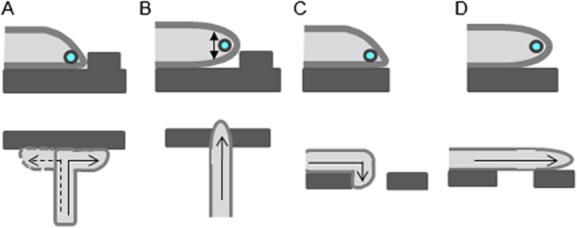Figure 8.

Model for the role of hyphal tip morphology in determining directional responses to surface topography.A. During growth on surfaces, hyphal tip asymmetry restricts growth to a site adjacent to the substratum. On encountering an obstacle, the reorientation of hyphal growth is permitted in the X–Y horizontal plane close to the surface. Wild-type hyphae are therefore forced to respond to relatively small obstacles by reorienting their direction of growth.B. The rounded tip morphology and meandering of the Spk in the vertical plane in rsr1Δ hyphae elevate the site of growth above the level of the substratum, thereby permitting growth over obstacles that would otherwise be perceived as barriers.C. An asymmetrical tip morphology drives growth towards the substrate so hyphal growth follows negative contours that slope away from the tip, permitting hyphal ingress into underlying depressions.D. In contrast, in cells that have not undergone tip contact or hyphae of the rsr1Δ mutant, where tip morphology is rounded, the penetration response into underlying discontinuities is lost.
